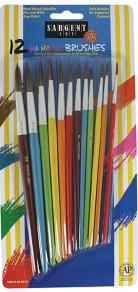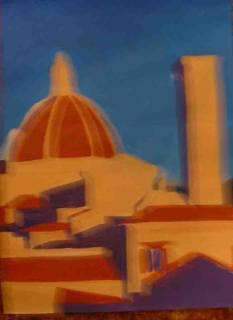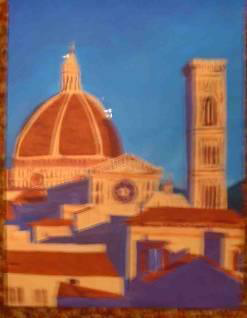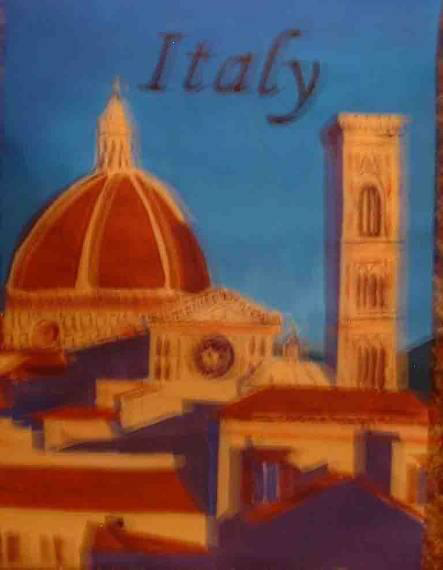Goal (Terminal Objective):
Students will create works of art demonstrating their use of a variety of acrylic painting techniques.
Objective:
Students will design and make travel poster with acrylic paints.
National Standards:
Visual Arts Grades 9-12 Content Standard 1: Understanding and applying media, techniques, and processes
Visual Arts Grades 9-12 Content Standard 3: Choosing and evaluating a range of subject matter, symbols, and ideas
Visual Arts Grades 9-12 Content Standard 4: Understanding the visual arts in relation to history and cultures
Visual Arts Grades 9-12 Content Standard 5: Reflecting upon and assessing the characteristics and merits of their work and the work of others
Purpose:
Students will select a subject representative of a chosen destination. Students will apply their understanding of color blending, scumbling, and drybrush to the creation of an original painting.
New Vocabulary:
color blending, scumbling, and drybrush
Materials:
paper or board

#24-2499 Acrylic Paint

#56-6012 12 ct. Natural Hair Rainbow Brush Assortment
Time:
This lesson may be modified to last from 3 to 6 hours.
Introduction and Motivation (Set):
Teacher presents photographs from magazines, post cards, posters, etc. of a variety of interesting destinations (mountains, islands, cities, and so on).
Instruction:
Teacher reviews color wheel. Teacher presents information on warm and cool color schemes, complementary colors, and color value.
Activities:
(1) Guided Practice:
- Students draw a representative view of their chosendestinations.
- Students paint their travel posters, developing shading and texture with appropriate color choice and paintingtechniques.
- Students select the best location in their compositions to add the name of the destination and other relevant text. They carefully draw the letters in pencil. Fonts may be selected from a sample page printed from a wordprocessor.
- Students may paint the letters or draw them withmarkers.
- Clean up with soap andwater.


(2) Independent Practice and Check forUnderstanding:Teacher circulates among the working students visually recording (checklist) students demonstrating understandingof objectives, asking direct questions when understanding isn’t observable, asking peers to critique each other. Teacher helps and reinforces students as they work.
(3) Closure: Students display their final paintings for a classcritique.
Evaluation:
Finished paintings may be displayed in the classroom. Use teacher or class critiques to evaluate particularly strong works and strong qualities within works.
Level One — The finished painting clearly displays a strong composition, accurate drawing, and a range of colors within a clear color scheme. The painting displays all three techniques: blending, scumbling, and drybrush applied in a manner that enhances the composition. Lettering works well in the composition and is drawn or painted clearly and professionally. The paint is applied smoothly and blended evenly. All colors are clear and vivid. The student used materials creatively to create an interesting visual message. Craftsmanship is excellent.
Level Two — The finished painting clearly displays a strong composition, accurate drawing, and a range of colors within a clear color scheme. The painting displays all three techniques: blending, scumbling, and drybrush. Lettering works well in the composition and is drawn or painted well. The paint is applied smoothly and blended evenly. All colors are clear and vivid. The student used materials appropriately to create an interesting visual message. Craftsmanship is good.
Level Three — The finished painting displays an appropriate subject, although the composition has weaknesses. Drawing has important weaknesses; color relationships are weak as well. The painting displays at least two of the three techniques: blending, scumbling, and/or drybrush. Lettering is awkward messy or poorly placed. The paint is applied smoothly and blended evenly. All colors are clear and vivid. The student used materials appropriately. Craftsmanship is variable.
Level Four — The finished painting does not show thoughtful color choices. Values are flat. The paint is poorly applied. Color blending may be incomplete or murky. Edges are messy. The student used materials inappropriately. Craftsmanship is poor.
Extension:
This project can be extended to create larger paintings.
Resources:
www.italiantourism.com
fpc.dos.state.fl.us
www.colorado.com
Art Consultant



